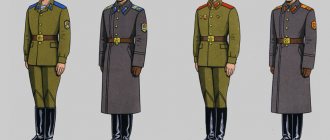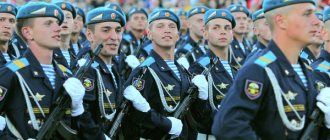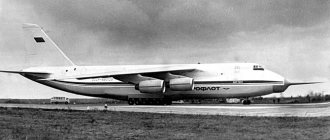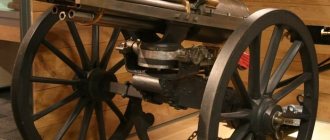Daily menu for conscripts
As a rule, food is healthy and unhealthy. Therefore, the soldier's menu must be properly balanced. When compiling it, the required amount of carbohydrates, fats and proteins for the normal functioning and development of the fighters’ young body must be taken into account.
Meals in the army are carried out strictly according to the daily routine, 3 times a day, and at the same time every day. Proper nutrition is the key to health!
Breakfast
To properly nourish a fighter’s body and lift his mood after morning exercise, a tonic and nutritious breakfast is simply necessary. It is necessary to start the work of the young conscript’s body.
Standard breakfast menu for soldiers:
- Porridge (oatmeal, pearl barley, other healthy cereals), pasta or dumplings;
- Steamed or fried cutlet, chicken or boiled sausage;
- Bread and bun;
- Oil;
- Cheese;
- Boiled egg;
- Coffee, tea or cocoa with condensed or plain milk;
- Sugar.
Many would not call this breakfast rich. But this is quite enough for the fighter to overcome combat training classes and hold out until lunch.
Dinner
Anyone who has already served a military service knows how soldiers wait for their lunch break. The first half of the day after a light breakfast is often quite difficult. But this is military service with its hardships and hardships.
The lunch ration of a conscript soldier in the Russian army is richer than breakfast. The fighters need to restore expended energy in the first half of the day with a hearty lunch.
Lunch menu:
- For the first course - cabbage soup, borscht, rassolnik or soup with any healthy cereal (barley, rice, etc.);
- For the main course - a side dish of pasta, buckwheat or rice, fish or chicken, beef, pork;
- Fresh vegetable salad or vinaigrette (they contain the largest amounts of vitamins necessary for a young human body);
- For dessert, the army usually serves compote made from fresh berries or dried fruits.
Dinner
Dinner, for both civilians and military personnel, should be healthy, but at the same time light. As a rule, after dinner there is no longer any physical or mental activity, and the body prepares for sleep.
Soldier's dinner menu:
- Side dish – rice, millet, buckwheat porridge or mashed potatoes. Oil must be added to any of the listed dishes. Also for dinner they can cook corn with peas, beans or dumplings, to which they always add sour cream;
- Stewed or fried fish;
- Bun;
- Compote or tea.
When compiling a soldier's menu, cooks must take into account the characteristics of a young body, daily physical activity, the absorption of specific foods, and the calorie content of food. Nutrition must be properly balanced. Therefore, the professionalism of the chefs plays an important role in preparing dishes for fighters.
As an example, you can take pearl barley. In the Russian army in the old days, the usefulness of porridge made from this cereal was highly valued. She gave the fighters strength. Therefore, pearl barley porridge is used in the soldier’s diet to this day. Of course, the modern recipe for making pearl barley is somewhat different from the ancient dish.
Many Russian citizens even have the opinion that a soldier’s diet only includes barley porridge as a side dish. In fact, in the Russian army, conscripts are boiled barley 1-2 times a week.
How they feed in foreign armies
The standardized menu in different countries has certain differences, which will be interesting for military personnel or conscripts to learn about.
USA
Nutrition in the American army is noticeably different from the Russian one, for the better.
In the United States, the diet is taken very seriously. A special research center is working on compiling a menu for military personnel.
Food in America is no different for ordinary soldiers and officers. They have general nutritional standards.
The variety of diets in the American army is very large. This is explained by the fact that the military personnel of this country have different nationalities and religions. Therefore, cooks have to prepare a huge number of dishes to provide each soldier with a suitable menu.
For the convenience of soldiers who are on a diet or for other reasons are forced to count calories, cooks indicate the number of calories in each dish. In 2022, military personnel are increasingly thinking about healthy eating. Nowadays in the American army it is no longer possible to see dishes that do not contain calorie content. Now soldiers can independently calculate how much food they should eat today in order to get their portion of calories.
For breakfast in the American army, as a rule, they serve various cereals or scrambled eggs. Supplement the diet with bacon. Dessert includes fruits, juices and fresh pastries.
Soldier's buffet
In the Russian army, such a phenomenon as the ability for conscripts to independently choose food from several prepared dishes is quite rare. But, in practice, in some military units they sometimes organize a so-called “buffet”.
Of course, for soldiers who have already lost the habit of comfortable civilian life, incl. from the choice of food - it’s just a holiday.
How the buffet is offered in practice in the army:
- Soldiers are given the opportunity to choose one of 2 first courses and side dishes;
- Some military units practice dividing portions. For example, a fighter can put half a portion of buckwheat and half rice on his plate, then half goulash and half chicken. This allows you to diversify your meals;
- The buffet also allows the soldier to make his own salad from his most preferred ingredients. On the common table there are several containers with already chopped and grated vegetables (radishes, cucumbers, tomatoes, carrots, beets, green onions, parsley, dill, etc.). At the same time, you can also choose sunflower oil or ready-made sauce for salad dressing.
Such privileges, of course, are not currently provided in all military units. But, soon, this practice may reach other departments.
Food in the Soviet Army
At 14.00 the Soviet Army had lunch. Lunch is as sacred as morning tea. By 14:00 in the afternoon, life in the armed forces came to a standstill. Fighters and bombers landed at airfields. The personnel hurried to the dining room, where the tables were set. Hot soup was served for lunch, and the same porridge for main course. The third is jelly (liquid jelly made from fruits) or compote (dried fruits brewed in boiling water). 50 minutes were allotted for lunch. Then half an hour to rest and 20 minutes to put yourself in proper order. Lunch is over - you can resume hostilities.
Captains A. Artyushenko and N. Kovalev, exercises of the Siberian Military District, November 1975. The black overalls have shoulder straps from their everyday uniform with shiny stars attached.
At 15:30 The second training cycle of the day began. On Mondays and Tuesdays at this time, political officers conducted political classes. On Tuesday and Friday, the crews worked on equipment; Friday was often declared a park day, when all working hours were spent on maintenance of military equipment and weapons. On Saturdays and Sundays, the personnel spent the afternoon in an organized manner engaged in sports for their own pleasure; football was very popular.
The salary of an ordinary soldier was 4 rubles 30 kopecks per month, a junior sergeant - 11 rubles 80 kopecks. Money was spent on smoking and sweets, while a Soviet soldier could always get booze anyway.
One and a half hours a day were allotted for personal time. Personal time ended at 20:10 with formation to go to the dining room for dinner. For the evening they were given 100 grams of fish, 300 grams of potatoes or porridge, black bread, 20 grams of butter. Tea was also served in the morning.
The quality of food was largely determined by the degree of efficiency of the officers and divisions responsible for rear services. The food problem poisoned the life of the entire Soviet people; the army even had to create its own agrotechnical complexes - military state farms. Many regiments raised chickens and pigs on their own and grew vegetables. Up to 5% of the personnel of the first line regiments were diverted to agricultural work. The regiments were recommended to completely switch to self-sufficiency in meat at the rate of 15 kg per person, in other words, the regiment was supposed to raise 28,000 chickens in a year.
Another additional source of food was ordinary state farms and collective farms. The officers negotiated with the leaders of agricultural farms on an exchange in kind: soldier labor for food.
The quality of the diet depended greatly on the type of troops. The construction troops were supplied worst of all (at the rate of 2800 calories), tankers and motorized riflemen were supplied at the rate of 3400 calories, and the best were jet pilots (5000 calories).
The role of the drink, which in the West is known as vodka, in the history of the army is truly legendary: there is prohibition everywhere and there are drunks everywhere! The lengths to which Soviet soldiers went to obtain and store alcohol-containing liquids deserve a separate study. Thus, the troops loved wheeled armored personnel carriers more than tracked infantry fighting vehicles. The technical and operational properties of the equipment were not taken into account at all. It was just possible to pour alcohol into the wheel chambers, but somehow alcohol could not be placed into the iron tracks of the tracks. The Air Force was very fond of the Tu-22 supersonic missile carriers - champions in alcohol content. Alcohol was usually used for cleaning contacts, but few people thought of wasting precious liquid on such nonsense. The jam sent from home served as an excellent raw material for making mash, or even moonshine, and standard fire extinguisher cylinders were used as containers for preparing alcohol. In terms of the amount of alcohol consumed, officers were not inferior, but rather superior to the rank and file.
Soviet pilots
1. MiG-21 fighter pilot of the Air Force frontline aviation
The pilot is wearing a VKK-3M altitude-compensating suit. In the 60s, such suits were required on every flight, but then became used only for high-altitude flights in the stratosphere. On the head is a GSh-4 pressure helmet, also designed for high-altitude flights. The blue bags contain emergency supplies.
2. MiG-23 fighter pilot of the Air Force frontline aviation
The pilot is dressed in a flight suit typical of the 80s, with a protective ZSh-3 helmet on his head. He holds a KM-32 oxygen mask in his hand. Standard clothing for a front-line aviation pilot.
3. Air Force technician in work clothes
Air Force ground support personnel at the airfield wore a work uniform consisting of trousers and a jacket in black or blue-gray, almost white. Headdress - takes the same color as the work uniform. Techies wore a shirt and tie under their jacket on very “formal” occasions.
Packed rations
The period of service of soldiers in the Russian army, as a rule, takes place not only within the military unit. Exercises are often organized with trips outside the garrison, incl. not for one day. Accordingly, food intake by military personnel is carried out in the field. Therefore, when carrying out such events, the diet of conscript soldiers of the Russian Army must include dry rations.
The amount of food in a dry ration depends on the duration of the planned field exercises. Dry rations are supplied for one meal or for a day at a time.
The composition and quality of soldering is strictly controlled, therefore special requirements are imposed on its configuration:
- In order to prevent possible poisoning and disruption of the stomach, dry rations are not supplied with perishable food products. These include eggs, mayonnaise, sausages, sausages, chicken, fresh fruits and vegetables;
- The ration includes instant food products or those that exclude such a procedure, but only those that are well absorbed by the young body; Food ration packaging must be durable and reliably isolate food from the effects of the natural environment.
Package contents of dry rations for soldiers:
- Canned food – canned buckwheat or pearl barley porridge with pork or beef, stew (chicken or meat), beans;
- Instant meals in bags for one-time meals - various soups, mashed potatoes (just pour boiling water over the contents of the bags and let it brew for a few minutes);
- Instant coffee, tea, dried fruits;
- Crackers, crackers and other baked goods with a long shelf life;
- Condensed and powdered milk;
- Spices - pepper, salt, sugar, sealed in special, well-insulated bags (daily allowance).
In addition to food ingredients, a soldier's ration package must include disposable tableware, napkins, means for heating food, and a water filter.
Field kitchen of Russian soldiers
Many are interested in the question of how conscript soldiers of the Russian Army are fed at training grounds in the field during long military exercises, which sometimes drag on for months.
As a rule, if such events drag on for several weeks or even months, military personnel independently set up a tent camp at the training ground. And since in such conditions one cannot get by with dry rations, because... fighters need hot food; a field kitchen is required, which is included in the tent camp.
The field menu is not as varied as in a military unit, but several options for dishes are still provided in the field eating conditions.
For breakfast, they most often eat pasta, buckwheat or rice with stewed meat, bread with pate or butter, hot cocoa (chicory) or tea.
For lunch, cooks cook pickle soup, borscht or cabbage soup, porridge with fish or meat, and also serve canned beans or peas.
In the field, potatoes are usually given for dinner, changing the method of preparing it daily (in jackets, stewed or mashed). For dessert, dried fruit compote is often prepared or tea is brewed.
The diet in the morning, lunch and evening must include bread, especially rye, which is most saturated with useful components necessary for the human body.











